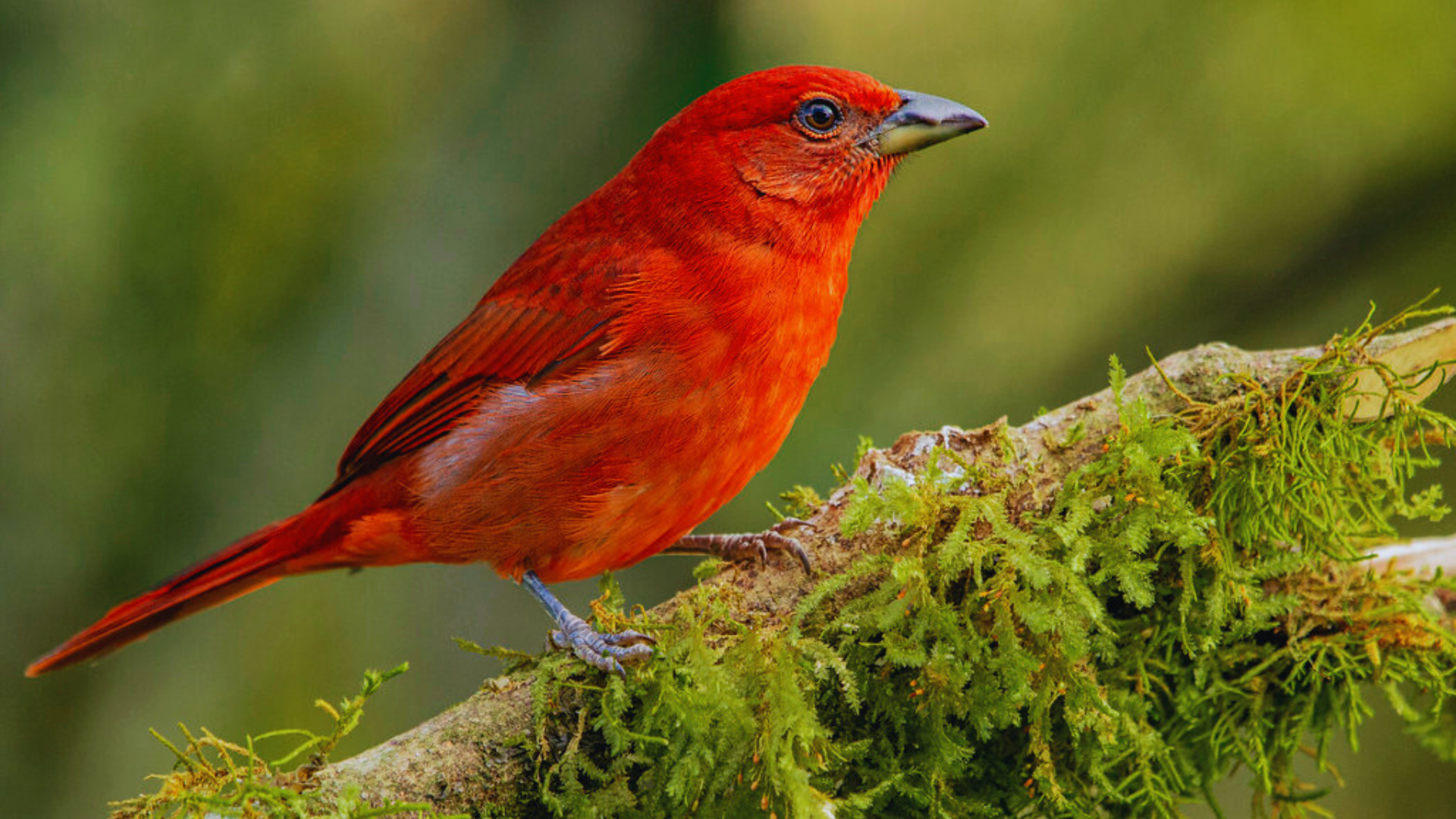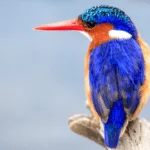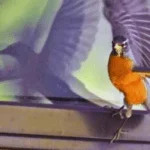As I wander through the vibrant landscapes of Texas, a familiar sight catches my eye – the flash of red wings. Red birds, a symbol of beauty and grace, grace our state with their presence.
In this article, I’ll take you on a journey to explore the various types of red birds found in Texas. We’ll delve into their habitats, migration patterns, and diets. We’ll also discuss the importance of conserving these magnificent creatures.
Get ready to soar alongside these crimson wonders.
Key Takeaways
- Red birds found in Texas include the Northern Cardinal, Vermilion Flycatcher, Red-bellied Woodpecker, Scarlet Tanager, and Painted Bunting.
- Red birds in Texas inhabit various habitats such as coastal marshes, tall pines, parks and residential areas, arid grasslands, and forests.
- Red birds in Texas migrate long distances, follow flyways, and make use of stopover sites along their migration routes.
- The diet of red birds in Texas primarily consists of seeds and insects, with berries and fruits as secondary food sources. They adapt their diet to the availability of resources.
Types of Red Birds Found in Texas
As I explore the topic of ‘Types of Red Birds Found in Texas’, I’m excited to share my findings.
Texas is home to a variety of beautiful red birds that captivate the hearts of birdwatchers and nature enthusiasts. One of the most common red birds found in Texas is the Northern Cardinal. With its vibrant red plumage and distinctive crest, the cardinal is a sight to behold.
Another red bird species found in Texas is the Vermilion Flycatcher, known for its bright red feathers and aerial acrobatics.
The Red-bellied Woodpecker is another red bird species that can be spotted in the forests of Texas, with its red crown and black and white barred back.
These red birds bring a splash of color and joy to the Texas landscape, making birdwatching in the Lone Star State truly remarkable.
Northern Cardinal

These vivid red birds are instantly recognized and widely cherished throughout the United States. This bird has black around its beaks and a body, head, and tail. The females are tan-gray in color; only the males have the renowned red plumage. These gregarious and sociable songbirds pair up for life and raise their offspring together. In addition to fruit, grains, seeds, insects, and sap, cardinals like visiting backyard feeders. These redbirds are widespread in the Southeast’s warm temperatures and do not migrate. In Texas, you can see northern cardinals year-round, and you can use sunflower seeds, peanut hearts, milo, and millet to entice them to your birdfeeders.
American Robin

In North America, robins are recognizable by their red color. The head, tail, and chest of this potbellied bird are all black, while its underparts and chest are rusty-red in hue. Its throat has a prominent white stripe as well. They inhabit regions with a high human population density and have a beautiful song. These robins are year-round residents of Texas, but they reach their peak population from early November to late March. They eat fruit, frogs, eggs, and small snakes. They would rather forage for food than eat birdseed. To draw in this species, scatter meal worms, diced apples, and berries throughout your grass.
House Finch
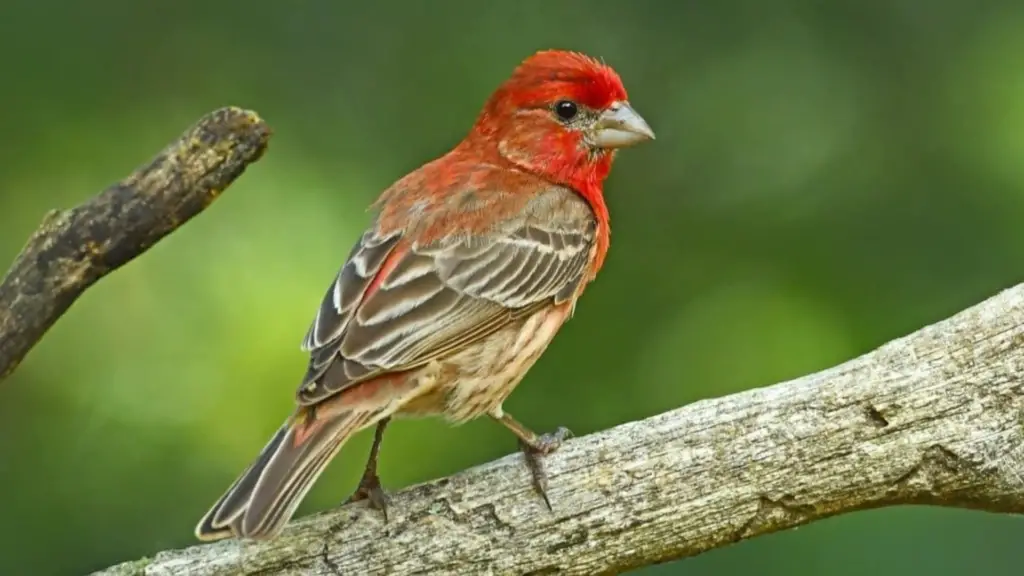
This little finch is widespread in the US, existing in practically every state and kind of habitat. It has short wings, a small bill, and a long, notched tail. Its abdomen is white with dark streaks, while its head and chest are reddish-orange in color. The house finch is a suburban dweller that is drawn to birdfeeders. It consumes insects, fruit, flower pieces, and weed seeds. Black-oil sunflower seeds are a great way to draw these lovely birds to your feeders.
Purple Finch

The purple finch, a migratory bird primarily found in the Northeast and Pacific Coast, is actually a rose red color. Throughout the winter months of October through April, they can be found in Texas, where they favor areas with fewer people. This bird has a notched tail and is short and stalky. Its head and rump are the brightest parts of its body, which is mostly red. Pale pink stripes adorn the brownish-gray back and tail. The primary foods of the purple finch are insects, buds, berries, and seeds. Sunflower seeds with black oil can be used to draw in this species.
Summer Tanager
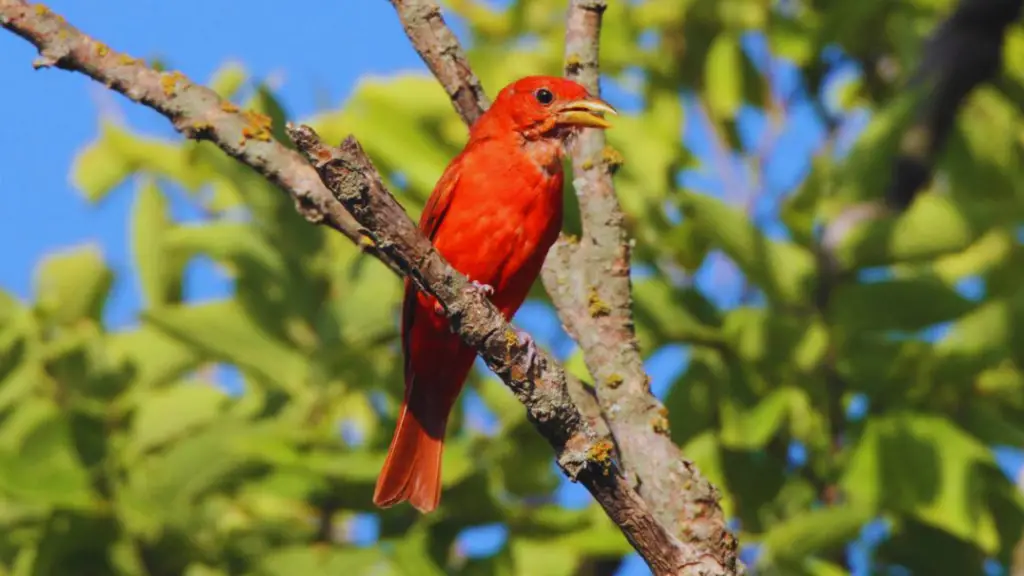
All year long in Texas, the summer tanager is a magnificently beautiful bird with blood-orange feathers. But during the spring migration and the summer, you can see them more frequently; this species has a larger body and sluggish motions. It is all crimson. These are forest songbirds that prey on wasps and bees and are typically found in woodland areas. To get summer tanagers to come to your yard, plant fruit trees and berry bushes.
Vermillion Flycatcher
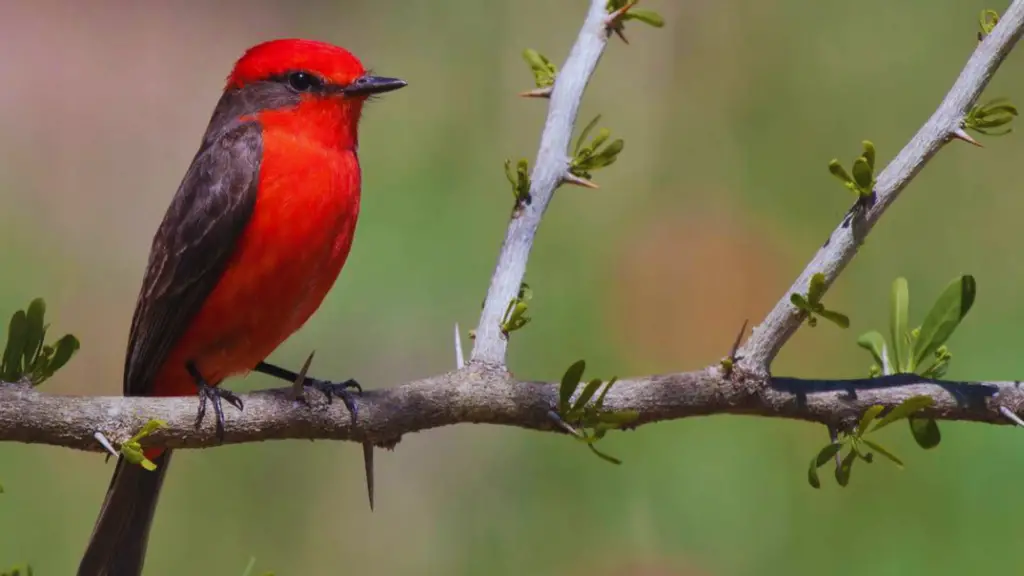
The brilliant red front of vermillion flycatchers is contrasted with brown across their face and back, creating the appearance of a mask. Brownish-gray females have faint red bellies. Although they are more prevalent in South Texas, they are very abundant throughout the year in Texas. They like to seek out and perch in desert areas to find insects. Mealworms are a good way to draw these red-throated birds.
Scarlet Tanager

The crimson tanager’s vivid red body, jet black wings, and tail make it very appealing. These colorful birds arrive in Eastern Texas during their migration in April and May. Some of them may remain through the winter, departing in January or February. They can be difficult to find because they prefer to consume fruit while perched high in the forest canopy. Planting berry plants like juneberry, blackberry, and huckleberry will draw these vibrant birds to your yard.
Flame-Colored Tanager
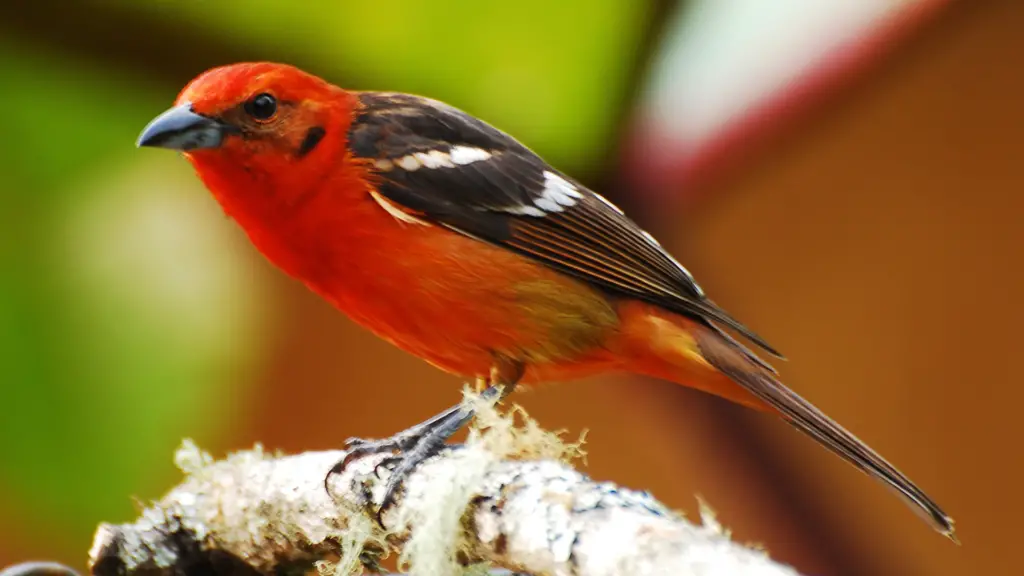
Tanagers with flaming colors feature orange-red bodies, gray wings, and white streaks running through their tails. Although it is mostly found in Mexico and Central America, this species is also becoming more and more visible in US states like Texas and Arizona. These uncommon birds are more likely to be seen between March and August in Big Bend National Park or near the Gulf Coast. It can be difficult to draw in and feed this bird with berries and insects.
Hepatic Tanager
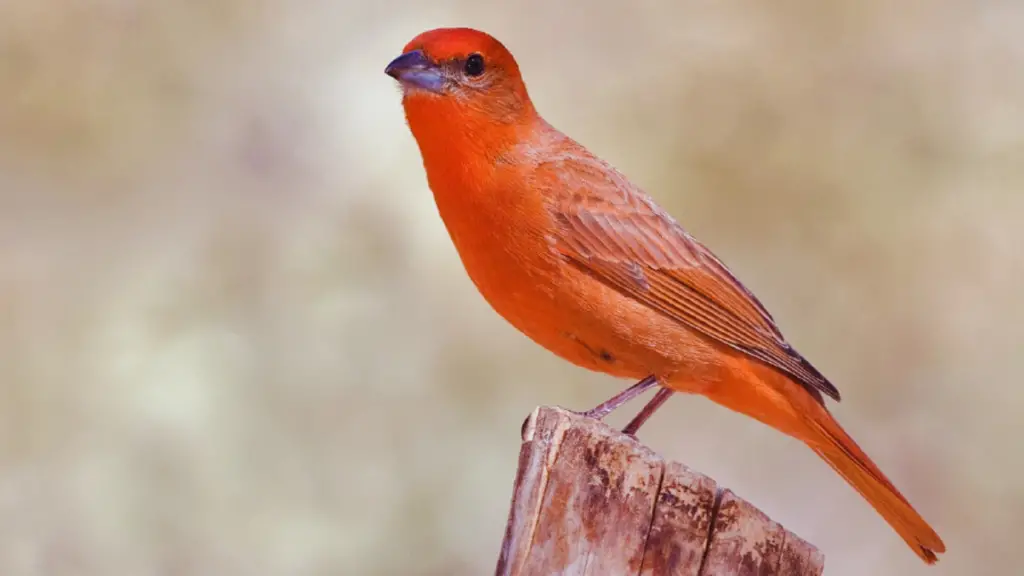
With the exception of its wings and back, which are brownish-gray, the hepatic tanager’s body is primarily colored reddish-orange. Although they are rare in Texas, you might be able to see this species of tanager in the summertime in the Davis Mountains and Big Bend National Park. They reproduce in the American Southwest and hibernate in Mexico, Central America, and South America throughout the winter. Their preferred environments are mountain ranges and woodlands, where they can freely consume berries, spiders, and other insects.
The Habitat and Range of Red Birds in Texas
Exploring the diverse landscapes of Texas, I’m amazed by the wide range of habitats where red birds can be found. From the coastal marshes to the dense forests, these vibrant creatures have adapted to various environments.
In the eastern part of the state, where the tall pines create a lush canopy, the Scarlet Tanager can be spotted with its striking red plumage contrasting against the green foliage.
Moving towards the central region, the Northern Cardinal thrives in parks and residential areas, delighting us with its beautiful chirps and bright red feathers.
As we venture west, the Vermilion Flycatcher can be seen darting through the arid grasslands, its vivid crimson hue a captivating sight against the desert backdrop.
Texas truly offers a haven for red birds, allowing us to witness their beauty and resilience in a multitude of habitats.
Migration Patterns of Red Birds in Texas
While observing the red birds in Texas, I’ve noticed interesting migration patterns. Here are some fascinating facts about their journeys:
- Long-distance travelers: Red birds in Texas embark on remarkable long-distance migrations, covering thousands of miles each year. They’ve been known to fly from their breeding grounds in Texas all the way to Central and South America.
- Seasonal movements: These beautiful birds exhibit seasonal movements, with the majority of them migrating south for the winter. They seek warmer climates and abundant food sources during the colder months.
- Flyways: Red birds in Texas follow specific migration routes known as flyways. The Central Flyway, which stretches from the Gulf Coast to the Great Plains, is a popular route for these birds.
- Stopover sites: Along their migration route, red birds often make stopovers at specific sites to rest and refuel. These sites provide crucial resources, such as food and water, allowing the birds to continue their journey.
As I continue to observe these magnificent creatures, I’m continually amazed by their resilience and ability to navigate vast distances.
Red Birds’ Diet and Feeding Habits in Texas
I have observed that red birds in Texas often rely on a combination of seeds and insects as their primary source of food, but they also consume berries and fruits when available. It’s fascinating to see how these vibrant creatures adapt their diet to the resources around them. To give you a better understanding, I’ve created a table showcasing the types of food red birds commonly consume in Texas:
| Seeds | Insects | Berries | Fruits | |
|---|---|---|---|---|
| Availability | High | Moderate | Moderate | Low |
| Nutritional value | High | Moderate | Moderate | Low |
| Preferred | Yes | Yes | Sometimes | Sometimes |
As you can see, red birds favor seeds and insects due to their high nutritional value and availability. However, they do indulge in berries and fruits occasionally. It’s a delicate balance of sustenance for these beautiful creatures that brings them closer to us and the environment they inhabit.
Conservation Efforts and Importance of Red Birds in Texas
One of the key ways to protect and preserve red birds in Texas is through active conservation efforts. As someone who deeply appreciates the beauty and importance of these magnificent creatures, I understand the significance of our actions in maintaining their habitat and population.
Here are four reasons why red birds deserve our utmost attention and care:
- Biodiversity: Red birds play a vital role in maintaining the delicate balance of Texas’ ecosystems, contributing to the overall biodiversity of the region.
- Ecosystem Services: These birds provide essential ecosystem services, such as pollination and seed dispersal, which are crucial for the survival of many plant species.
- Indicator Species: Red birds act as indicators of the overall health of the environment. By monitoring their population, we can gain valuable insights into the state of our ecosystems.
- Cultural Heritage: Red birds hold a special place in Texas’ cultural heritage, symbolizing resilience and natural beauty. Preserving their presence ensures the continuation of our rich traditions and stories.
Red Birds In Texas: FAQs
Are Red Birds Native to Texas?
Yes, red birds are native to Texas. They can be found in various species like the Northern Cardinal and the Vermilion Flycatcher. Their vibrant plumage adds a beautiful touch to Texas’ natural landscape.
How Do Red Birds Contribute to the Ecosystem in Texas?
Red birds contribute greatly to the ecosystem in Texas. They help with seed dispersal, control insect populations, and provide a beautiful sight. It’s fascinating to know that their vibrant red feathers make them easily recognizable.
What Is the Average Lifespan of Red Birds in Texas?
On average, red birds in Texas have a lifespan of about 3 to 5 years. They play a crucial role in the ecosystem by dispersing seeds, controlling insect populations, and adding beauty to our surroundings.
Are Red Birds in Texas Affected by Climate Change?
Yes, they are. Climate change impacts red birds in Texas by altering their habitats and food sources. It’s concerning to witness the effects firsthand, as these beautiful creatures struggle to adapt and survive.
Can Red Birds in Texas Be Kept as Pets?
Yes, red birds in Texas can be kept as pets. They make wonderful companions and bring joy to any home. However, it’s important to provide them with proper care, diet, and a spacious environment to thrive.
Conclusion
In our concluding thoughts, red birds in Texas aren’t only a beautiful sight to behold but also play a crucial role in our ecosystem.
Their vibrant plumage and melodious songs bring joy to our lives.
As the saying goes, ‘A bird in the hand is worth two in the bush,’ let’s cherish and protect these red birds and their habitats, ensuring a thriving future for both nature and ourselves.

